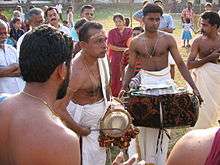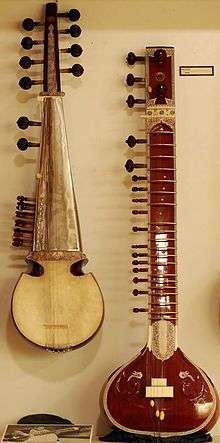Idakka
The idakka (Malayalam: ഇടയ്ക്ക, literally, in the middle), also spelt edaykka/edakka, is an hourglass-shaped drum from Kerala in south India. This handy percussion instrument is very similar to the pan-Indian damaru. While the damaru is played by rattling knotted cords against the resonators, the idakka is played with a stick. Like the damaru, the idakka's pitch may be bent by squeezing the lacing in the middle. The idakka is slung over the left shoulder and the right side of the instrument is gently beaten with a thin curve-ended stick.[1]
Etymology
It is believed that the word comes from the Malayalam word idakku, meaning "centre". The word is said to allude to the instrument's position between the temple idol and the devotees.

Construction
Similar to the talking drum, The Idakka consists of two circular drum heads each of which is mounted within a circular ring. The hourglass-shaped body is placed between the two heads and lacing is used to pull the two rings towards each other, stretching each drum head over an open end of the body. Snare-like strings made of natural fiber are stretched across the open ends of the drum body, under each drum head. It is not uncommon for the diameter of the drum heads to be larger than the diameter of the body, with the result that the drum heads are often seen mounted significantly off-center.
Acoustics
The Idakka is a small, high pitched drum with definite pitch. The snares running under the drum heads have been found to interact with the vibrating membrane in a way that causes the pitch of the instrument to be determinate.[2] Different pitches can be obtained by squeezing the lacing around the instrument, which changes the amount of tension in the skins.
See also
- Damaru
- Pandi Melam
- Panchari melam
- Thayambaka
- Panchavadyam
- Tripunithura Krishnadas
- Talking Drum, another drum in West Africa with an hour-glass shape.
References
- Deva, Bigamudre Chaitanya (1995). Indian Music. Taylor & Francis. ISBN 9788122407303.
- Jose, Kevin; Chatterjee, Anindya; Gupta, Anurag (April 2018). "Acoustics of Idakkā: An Indian snare drum with definite pitch". The Journal of the Acoustical Society of America. 143 (5): 3184–3194. Bibcode:2018ASAJ..143.3184J. doi:10.1121/1.5038111. PMID 29857748.
External links
| Wikimedia Commons has media related to Idakka. |

